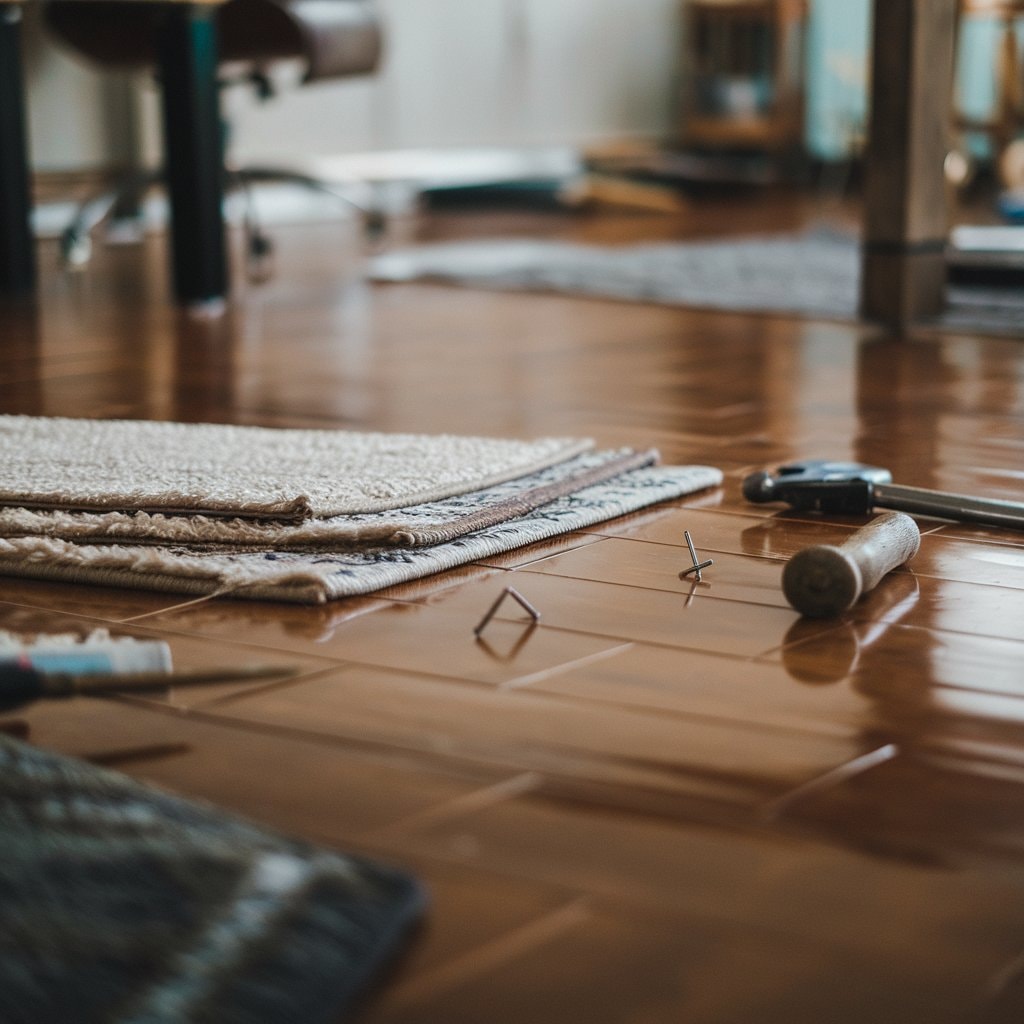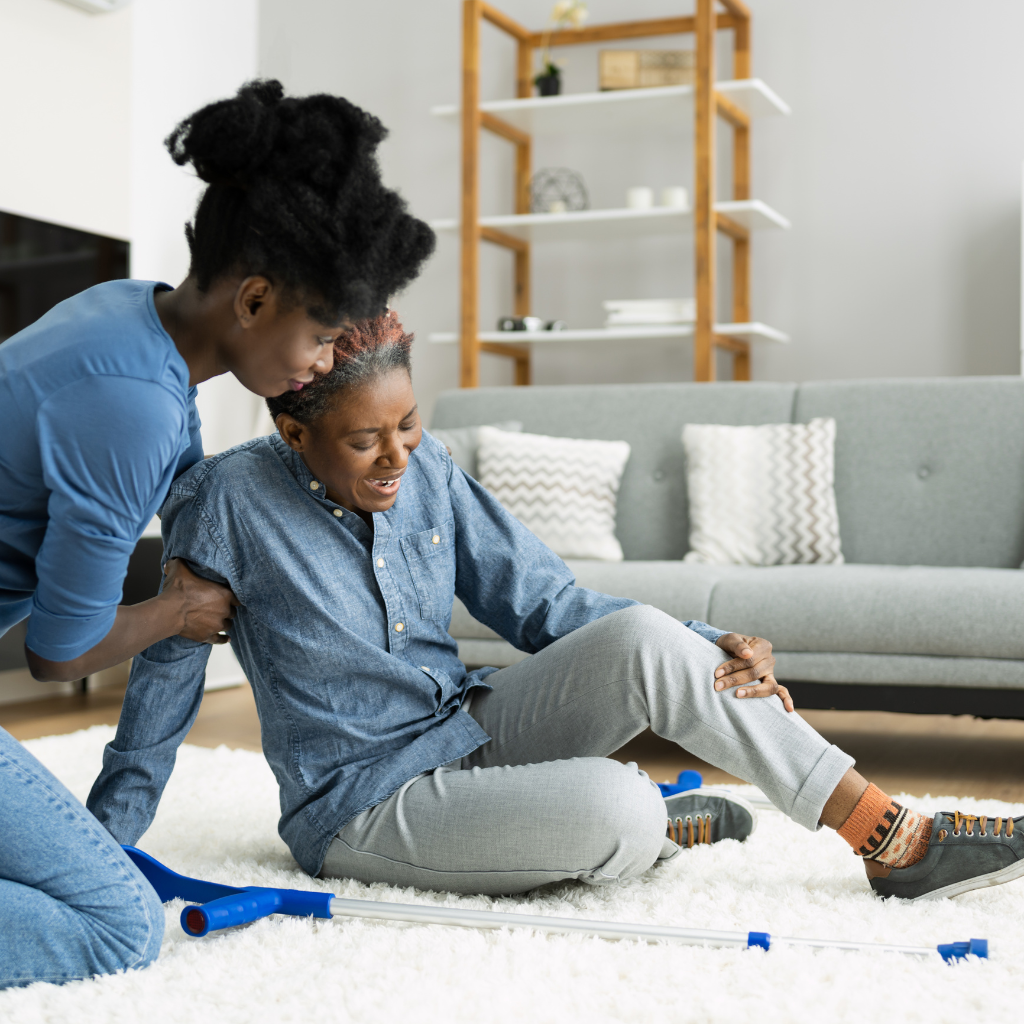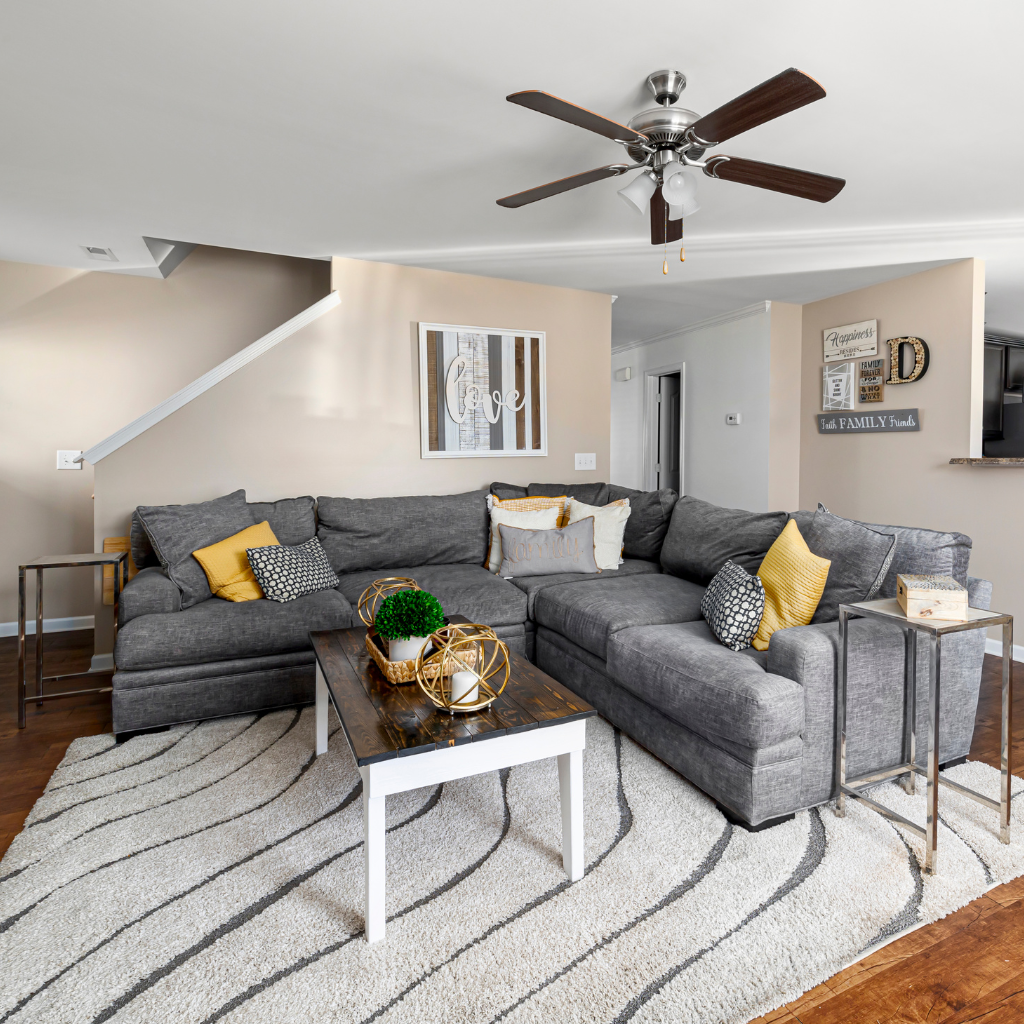A common challenge many homeowners face is how to stop carpets from slipping. This issue can make your home feel less secure and cause inconvenience. Our guide offers practical solutions to prevent rugs from moving on the carpet ensuring your floors stay safe and stylish.
With years of experience as a mobile flooring shop, we've helped countless customers find the right flooring options for their homes. We know the importance of keeping your Rug in place on top of the carpet.
Read on for expert advice on tackling this problem efficiently.
Securing a rug on top of a carpet requires effective methods to prevent slipping and sliding. Using double-sided carpet tape is one popular solution. This adheres to both your Rug and carpet, creating friction that stops movement.
However, take caution as some tapes may damage delicate carpets. Another reliable option is investing in a non-slip rug underlay explicitly designed for use over carpets. These underlay help to keep your Rug in place and also protect the carpet underneath from wear.
Exploring different materials like natural rubber or polyvinyl chloride in these products could provide extra grip without harming your flooring. Now, understanding why rugs move on the carpet will help you discover the perfect solution for your home.
Maintaining a stable position for your Rug on a carpet is crucial not only for safety considerations but also for a pleasing aesthetic. The ideal location of the rug prevents unintentional movement, avoiding slips and slides, thereby harmonising your décor elements.
As we continue to explore other effective strategies for creating a safe and chic home setting, let's further examine the utility of double-sided carpet tape in preventing rug displacement.
Transitioning from the best methods to keep your Rug in place, we turn our attention to double-sided carpet tape. This adhesive solution offers a strong bond between the Rug and carpet, making it a popular choice for preventing slips and slides.
Users appreciate its ease of application; you simply apply the tape along the edges or underside of your Rug and press down firmly onto the carpet.
Double-sided carpet tape's effectiveness lies in its pressure-sensitive adhesive properties, allowing both immediate grip and long-term stability without damaging the surface beneath.
Despite concerns over residue, most high-quality tapes are designed to leave no trace when removed properly. For those looking to stop their rugs from moving around on carpets efficiently, this product proves itself as an essential tool in maintaining home safety and aesthetic appeal.

While double-sided carpet tape provides a short-term solution to rug movement, non-slip rug underlay offer a longer-lasting answer. These underlay serve as a barrier between your Rug and the carpet, augmenting friction to avoid any slipping or sliding.
Crafted from materials like felt, rubber, or PVC, non-slip underlay are purposed to affirm the position of your rugs without harming the carpet pile beneath.
Utilising a non-slip underlay halts rug movement and also supplements underlay. This enhances the walking experience and prolongs the lifespan of both the Rug and the carpet beneath by minimising wear.
They're compatible with all sorts of flooring surfaces, encompassing hard floors and high-pile carpets. Selection of the correct-sized underlay is essential; it should be marginally smaller than your Rug to confirm that edges do not curl upwards, posing a tripping hazard.
Rugs move on the carpet for several reasons, the main one being the interaction between the Rug and the carpet's pile. This movement often results from foot traffic over the Rug, causing it to slip and slide.
The choice of carpet is a key factor here; deep-pile carpets offer more cushion but less stability for rugs placed on top of them, leading to more movement. On the other hand, low-pile or tightly woven carpets provide a firmer foundation that can help keep rugs from moving as much.
Certain types of rugs are more prone to slipping because of their backing material. Rugs without a non-slip base or those made from smoother fabrics tend to move around more easily.
Factors such as the size and weight of the Rug also affect how likely it is to shift - lighter rugs may only stay put with additional support like anti-slip underlay or double-sided tape specifically designed for this purpose.
Ensuring your home's safety goes beyond simply aesthetics; securing your Rug in place protects everyone who walks over it.
The main reason rugs slip and slide on the carpet is the lack of friction between the Rug's back and the carpet pile. As people walk over a rug, pressure pushes it down onto the carpet, causing both surfaces to rub against each other.
Without enough grip at this interface, rugs easily move out of place. This movement becomes more pronounced with smooth-backed rugs placed atop high-pile carpets where there's more surface for slipping.
Another factor comes from everyday use: as furniture moves slightly or when vacuuming, even if you just lightly bump a corner. Over time, these small shifts can cause your Rug to start creeping across the room unless it's secured properly.
Materials like double-sided rug tape and non-slip underlay provide solutions by increasing resistance against sliding movements, keeping your living space both safe and stylish without damaging your carpet or hard surface floors.
Carpet pile height and density crucially affect rug movement on carpets. High-pile carpets, characterised by their longer fibres, provide a plusher surface. This plushness enables rugs situated on top to shift with less difficulty since the Rug lacks a firm base to latch onto.
On the contrary, low-pile or compactly woven carpets present a sturdier foundation for rugs, minimising slippage. Rugs are more inclined to remain stationary on these carpet types.
For instance, Loop Pile Carpet offers a tighter, more structured weave that provides a better grip for rugs placed over it, making it a preferred choice for reducing rug movement.
Furthermore, the orientation of the carpet pile can sway rug movement. If a rug is positioned contrary to the natural flow of the carpet pile, it may move or creep as people traverse over it.
Homeowners and interior designers must take into account both the type and condition of the carpet pile when opting for non-slip solutions like anti-slip underlay or double-sided rug tape to effectively deter rugs from slipping on carpeted floors.
Rugs with a smooth back, such as those made of silk or fine wool, are more prone to slipping on the carpet. Their sleek surfaces lack the grip necessary to stay put on top of another rug.
On the other hand, rugs made from heavier materials like jute or those with a knotted-pile construction tend to move less because their weight and texture provide better stability.
A rug's material can significantly impact its ability to stay in place. Choosing the correct type of flooring is key to preventing movement.
This insight helps homeowners and decorators make informed decisions when selecting rugs for rooms with carpeting. Opting for rugs that naturally resist moving can eliminate the need for additional anti-slip measures.
One of the premium options to secure your Rug from sliding on the carpet involves the use of double-sided rug tape. This specific tape adheres solidly to both the rear of your Rug and the peak of the carpet, establishing it without inflicting harm.
A further highly productive solution is a non-slip rug underlay. These underlay are positioned beneath rugs to preserve their stillness, enhancing safety by minimising the chance of slipping and falling.
Non-slip rugs are furnished with unique backing created from materials that hold onto both solid floors and carpets. When selecting these items, seek qualities such as longevity, simplicity in cleaning, and adaptability to varying types of flooring. These features are beneficial during carpet tile adhesive removal, when maintaining surface stability is crucial to avoid shifting rugs and potential hazards.
Choosing anti-slip solutions secures rugs solidly in place and also prolongs their usability by preventing their bunching and deterioration.
Rug tape, particularly double-sided carpet tape, provides a simple and effective solution to stop rugs from moving on carpets. It firmly secures the Rug in place without damaging the carpet underneath.
This method works well on various surfaces, including hard floors and carpets, making it versatile for different home settings.
Users find double-sided rug tape convenient because it's easy to apply and remove. This makes repositioning your rug hassle-free while ensuring it stays put during daily use. The adhesive quality of high-standard rug tapes means that even heavy foot traffic won't cause the edges of your Rug to lift or slide, keeping your home safe from tripping hazards.
Anti-slip rug underlay create a barrier between the Rug and your carpet. They use friction to prevent rugs from moving on carpets. The underlay contain tiny grips that latch onto both surfaces firmly.
This action stops any sliding or creeping, even when you walk over the Rug. Rug underlay are handy for areas with high foot traffic, like living rooms.
Choosing the right non-slip underlay involves looking for ones made of materials that grip well without damaging your carpets or hardwood floors beneath them. Quality is key, as some underlay may disintegrate over time and cause more harm than good, especially on wood flooring.
For homeowners, interior designers, and builders seeking reliable solutions to keep rugs in place, selecting an anti-slip underlay offers a practical way to enhance safety and comfort in homes without resorting to damaging adhesives like double-sided tape.
Choosing the right non-slip Rug for your home involves looking at several key features. These features ensure your Rug stays in place, preventing it from moving on the carpet.
Selecting furniture to complement your choice is next on our agenda.
Positioning your Rug using furniture is a clever tactic to limit your Rug's movement on the carpet. Heavy items like sofas or tables on the corners or peripheries of a rug can drastically diminish sliding.
This technique is most effective with living room rugs, where furniture naturally settles on these fabrics. It secures the carpet and enhances the room's design pattern.
For the best stability, evaluate how you position your furniture around or above your large rugs. Make sure that frequently used items, such as chairs or coffee tables, are securely fixed to the carpet.
This not only halts movement but also creates a harmonious aesthetic in any room. Homeowners and interior designers alike appreciate this method as it blends practicality with elegance, making it a favoured option for maintaining rugs on carpets without resorting to extra products.
Securing your Rug with furniture pieces is a simple method to avoid its movement on your carpet. By positioning essential furniture pieces, like a sofa or coffee table, partially on the Rug's edges, the carpet stays in its place, even when walked on.
This is a practical strategy to utilise the available items in your home to maintain your rug static, ensuring everything stays steady without extra cost.
Employing furniture to secure a rug not only brings steadiness but also delineates your living area more distinctly.
Correct placement of these items will keep the Rug's edges tightly held by heavy objects, hindering any corners from turning up or shifting. This technique works well for more extensive large rugs that can have at least one furniture piece on top.
Following up, we will discuss how the selection of appropriate furniture placements can further aid in achieving desired rug stability.

Choosing the proper furniture placement can significantly enhance rug stability. This method prevents your Rug from moving on the carpet, ensuring it stays in place.
Next up: Does Rug Size Affect Movement on Carpet?
After discussing the optimal furniture placement for rug stability, it's crucial to delve into the advantages and disadvantages of using furniture to secure rugs. This method, while popular, presents a mix of outcomes that could affect your decision-making process. Here's a comprehensive table to break down the pros and cons:
| Pros | Cons |
|---|---|
| Immediate solution without needing extra purchases | Can cause uneven wear on your rug |
| Enhances room aesthetics by coordinating furniture and rug placement | Limits rug and furniture arrangement options |
| Utilises heavy furniture pieces, making it a sturdy method to prevent slipping | Not suitable for lightweight or delicate furniture |
| No need for adhesives that might leave residues on carpet | Rug might still slip under less heavy furniture pieces |
| Can be adjusted easily for cleaning or redecorating purposes | Potential tripping hazard if the rug edges lift |
Securing rugs with furniture offers an easy fix to the common problem of rug movement, especially for homeowners looking for a quick solution that doesn't involve additional spending or installation efforts. However, it's essential to consider the potential for uneven wear and the restrictions it may place on room layout. This method proves most effective when paired with other rug-securing techniques, ensuring both aesthetic appeal and functionality within the space.
Large rugs are less likely to move compared to smaller ones. The larger surface area of oversized rugs means they have more contact with the carpet underneath. This extra contact helps keep them in place, especially when walked on or vacuumed.
Smaller rugs lack this advantage and, therefore, tend to slip more easily. Rug underlay plays a crucial role in preventing movement across all rug sizes.
Choosing the right size of rug underlay can make a significant difference. For small rugs, it's vital to pick out a non-slip underlay that fits well beneath them to stop moving on your carpet.
These underlay increase friction between the Rug and carpet, effectively holding your Rug firmly in place, whether you're using a large area mat or a smaller runner or Rug.
Large rugs have a weight advantage that makes them less prone to slipping and sliding on carpet. Their size and mass mean they cover more ground and stay put under their weight, making them a solid choice for stability.
This doesn't stop your Rug from moving entirely, but it reduces the risk significantly compared to smaller rugs or runners placed on top of the carpet.
Using non-slip rug underlay beneath these large rugs enhances this effect even further. These underlay grip both the carpet and the bottom of the Rug, creating friction that prevents movement.
So, for those hoping to keep a large rug firmly in place, combining its natural tendency to stay still with a quality non-slip underlay offers a reliable solution to stop your Rug from moving on the carpet.
Choosing a rug underlay is essential for securing your Rug on carpet surfaces. These non-slip rug underlay typically have unique textures that secure the Rug's bottom and the carpet's top, creating friction that prevents movement.
Their build features various materials such as rubber or felt, which effectively hold the rugs in place, even in areas with high foot traffic where slipping is most prevalent. This method keeps your Rug stable while also preserving its longevity by diminishing wear and tear.
Rug underlay perform optimally when accurately paired with your rug size; they should be slightly smaller than the Rug to keep edges flat and hidden. Maintaining your home's safety becomes more achievable with these underlay as they counteract tripping threats caused by piled-up rugs or loose runners.
Now, we'll discover how small rugs can utilise similar techniques to stay in position.

Small rugs often move around, causing inconvenience and potential tripping hazards. Stopping them requires simple yet effective measures.
Each method offers a way to secure small rugs, ensuring they remain stationary on top of carpets, enhancing both safety and aesthetics in any room.
Identifying the ideal strategy to secure a rug on a carpet can preserve your home's safety and uphold your flooring's aesthetics. You can utilise double-sided carpet tape, anti-slip mats, hot glue, and strategically positioned furniture for this objective.
These strategies help stabilise rugs and mitigate accidents. It is beneficial to select products specifically designed to fulfil this function for effective results.
The optimal method relies on your requirements and the nature of the Rug or runner. From employing rug grippers for compact items to securing large patches of Rug with furniture, each tactic imparts its unique benefits.
Essential is important to evaluate the dimensions of your Rug and the texture of your carpet prior to making a decision. In doing so, you can ensure rugs, once placed on the carpet, remain stationary while also improving your home's interior design. Additionally, layering rugs can provide both aesthetic and practical benefits, adding extra stability and style to your space.